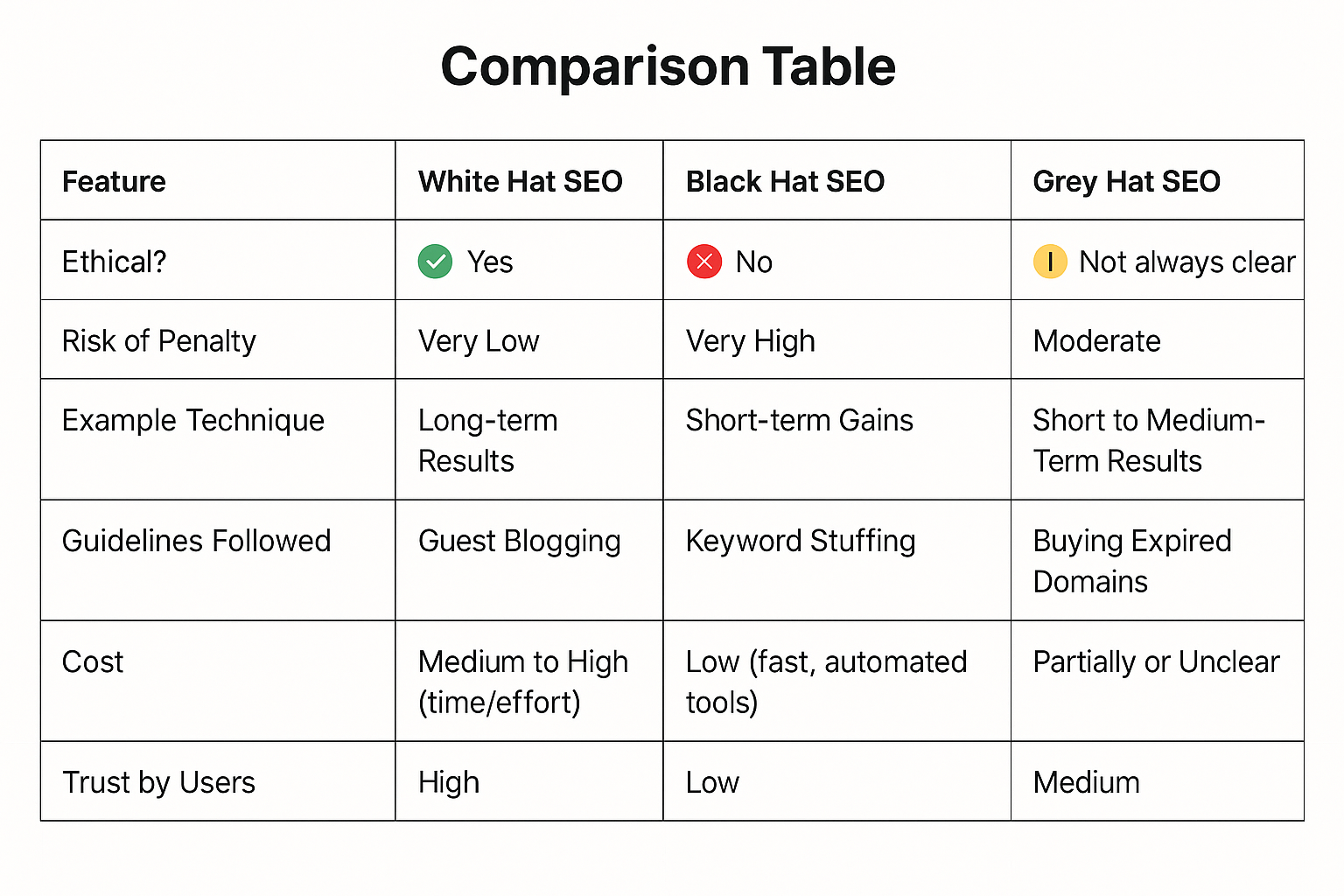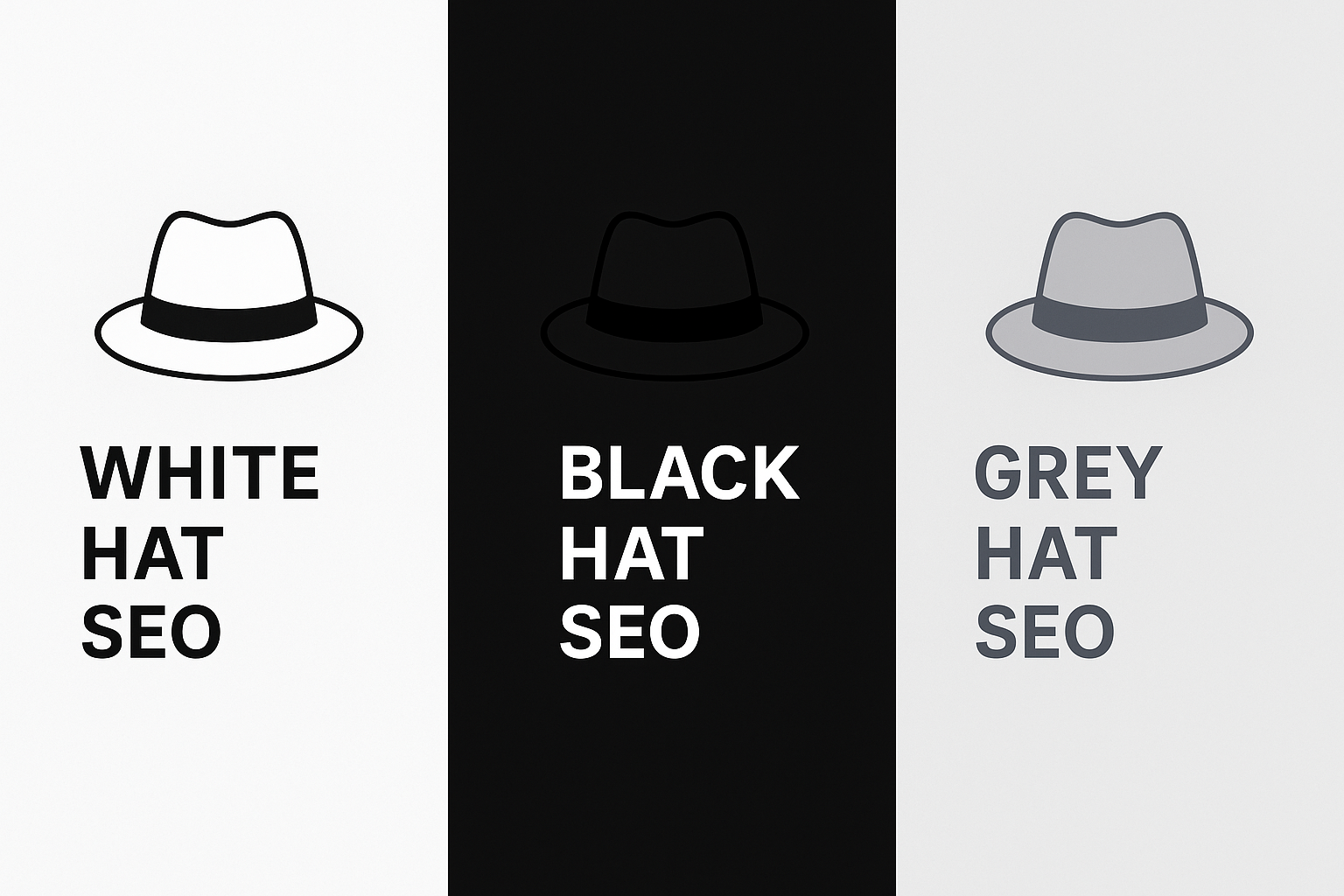When it comes to SEO yeah, that thing we all pretend to fully understand there is more than one way to climb the Google ladder. Marketers and business owners don’t all take the same route. Some play by the rules, some bend them like a yoga instructor and others just kind of dance in-between.
Basically, there are three types:
- White Hat SEO,
- Black Hat SEO,
- Grey Hat SEO.
So, let’s dive into each one, throw in a few real-life examples, and see what kind of SEO sorcery peoples are actually up to out there.
White Hat SEO
White Hat SEO is the good kid in class. It plays nice, follows the rules, and focuses on giving users what they actually want — helpful, relevant stuff. It is not flashy or sneaky, but it gets the job done. And better yet, it sticks around for the long haul. Think of it as the organic, slow-cooked version of SEO. No shortcuts. Just solid, honest work.
Techniques :
- Writing actually good content people want to read, doing keyword research that is not just stuffing “buy yoga mat” into every other sentence
- Making sure your site loads fast and does not break on someone’s phone screen
- Earning backlinks the hard way like through guest posts, building relationships, or PR shoutouts
- Using clean meta tags and alt text that describe things like a normal person would
Real-Life Example:
Say you’ve got a yoga blog. You write a super-detailed post called “Best Yoga Techniques for Beginner’s. It is original, easy to read, and sprinkled with genuinely useful tips. Health blogs and wellness sites start linking to it because its actually worth sharing. That is white hat SEO doing its thing. Slow? Maybe. Steady? Definitely. Effective? Absolutely.
Black Hat SEO
Black Hat SEO is the rebel. It is all about gaming the system — finding loopholes in search engine algorithms and squeezing every drop out of them for a fast win. No concern for rules, user experience, or ethics. Just pure “lets rank now and deal with the fallout later” energy. Sure, it might get you to the top of Google overnight… but do not get too cozy. That same shortcut can send your site into digital exile next week.
Tricks of the Trade (that you probably should not try):
- Stuffing keywords like your life depends on it
- Cloaking (showing one thing to Google, and something totaly different to visitors
- Buying backlinks from shady corners of the internet
- Hiding text or links in plain sight (like white text on a white background — not exactly subtle)
- Copy-pasting or auto-generating content like a robot with no soul
- Using PBNs (Private Blog Networks) to fake authority
Example:
Let’s say a site is trying to sell a magic fitness drink. Instead of writing helpful content, it hides a wall of keywords like “buy fitness drink online fast cheap now” in invisible white-on-white text. Google sees it (for a little while), users don’t. That is classic Black Hat. And yeah — it is a big no-no.
Risk Level
Sky high. You might get a brief boost, but search engines will catch on. And when they do? Say hello to penalties, rankings crash, or even a full-on ban from the index.
Grey Hat SEO
space between playing it safe and going full rouge. It is like saying, “Hey, I’m not technically breaking the rules,” while doing things that Google might raise an eyebrow at — if it notices. These tactics are not spelled out as wrong, but they are not exactly encouraged either. Kinda like jaywalking when no one’s around. It is riskier than white hat, not as wild as black hat, and sits in this murky middle ground where things might work… until they don’t.
Common Grey Hat Moves:
- Writing clickbait titles that actually deliver on the hype
- Spinning content — basically taking existing articles and changing just enough words to not get caught
- Snagging expired domains that already have backlinks, and pointing them at your site
- Making microsites that exist just to send you backlinks
- Repeating exact match anchor text, a little too much
Example:
Imagine a brand finds an old website — like, a blog about healthy snacks that is been offline for a year but still has solid backlinks. They buy it, slap on a redirect, and now all that link love flow’ to their granola bar store. Not against the rules per se… but also not exactly squeaky clean.
Comparison Table



